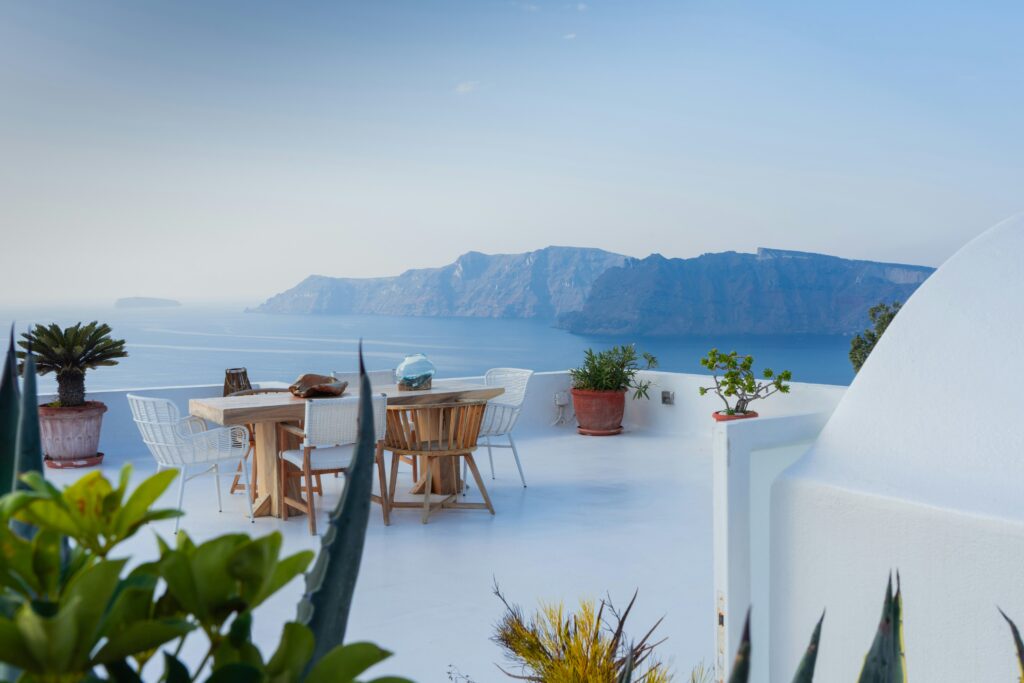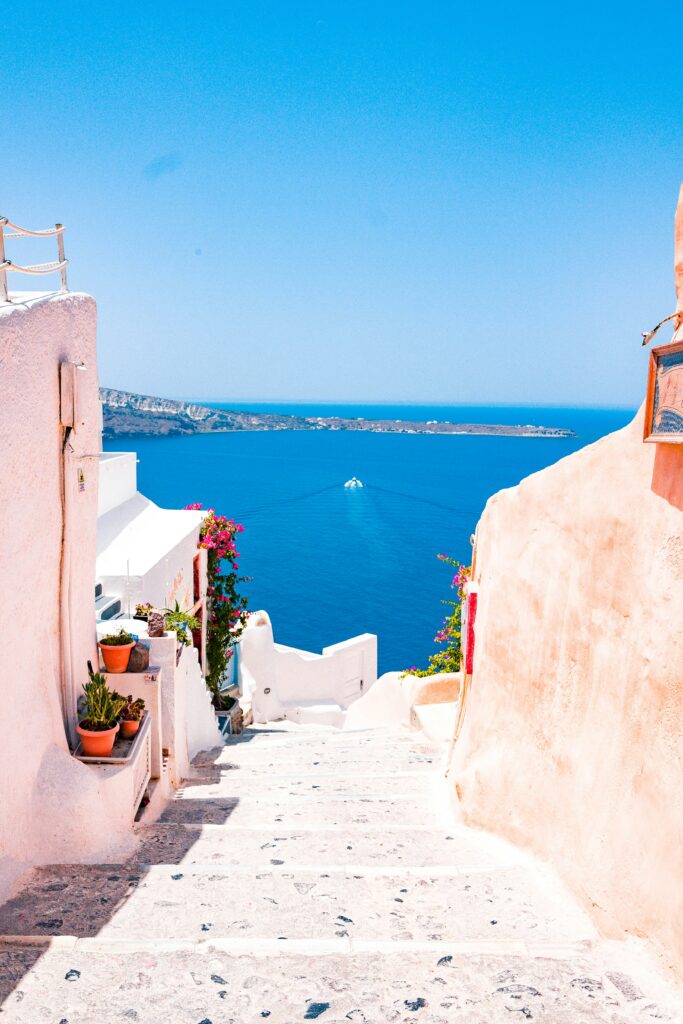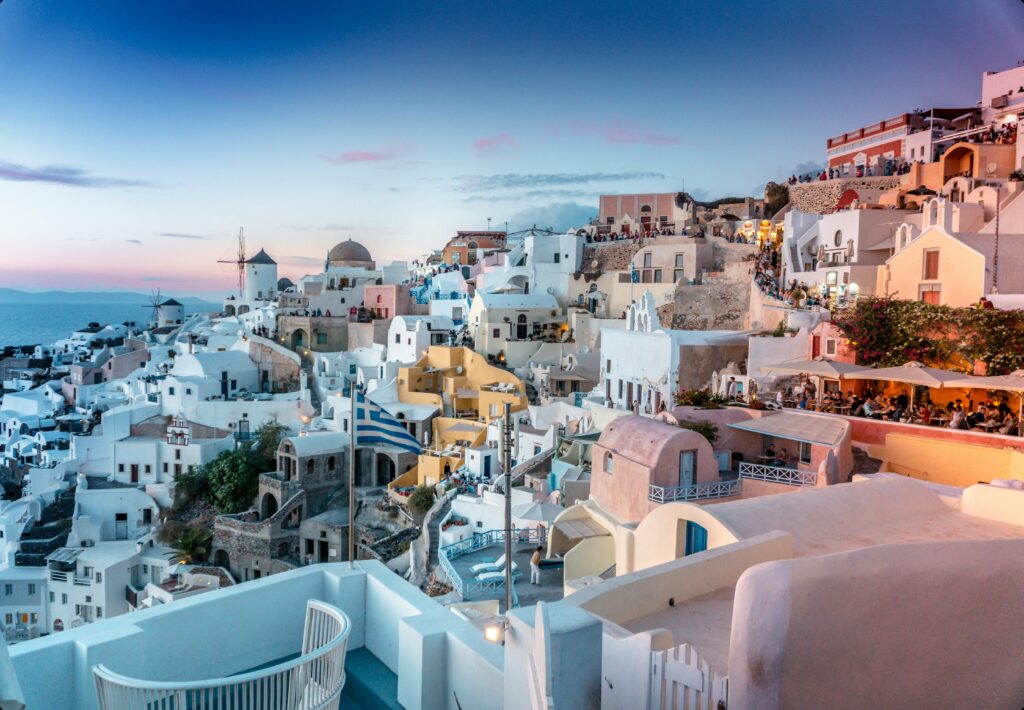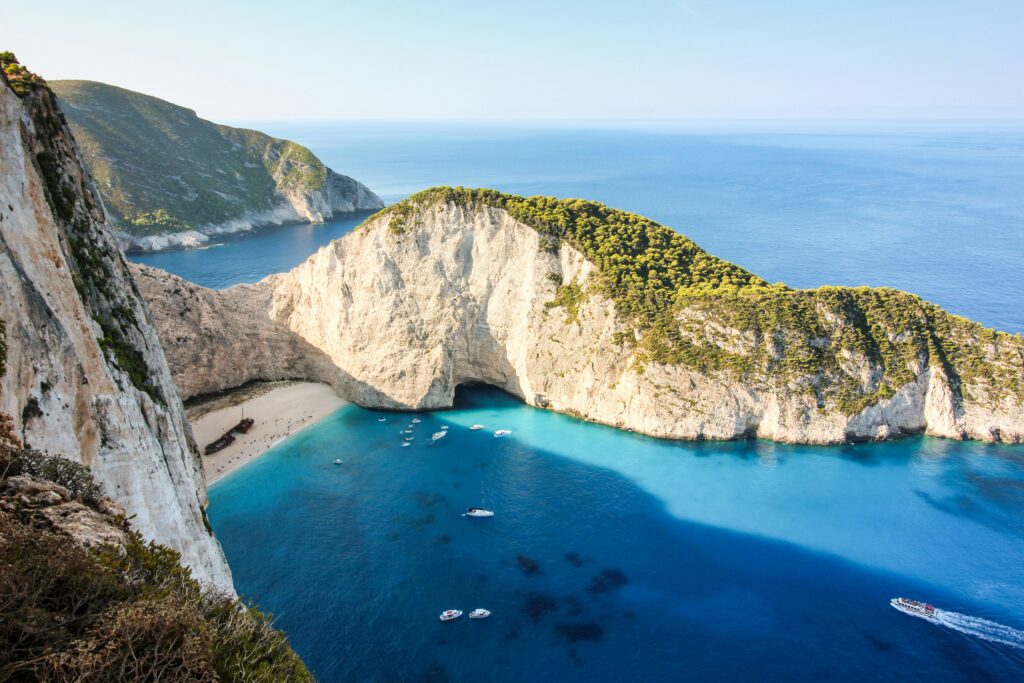Santorini doesn’t look like it should exist. The crescent-shaped island—what remains after a volcanic eruption so massive it may have inspired the legend of Atlantis—rises dramatically from the Aegean in layers of rust, charcoal, and bone white. Villages cling impossibly to cliffsides, their cubic houses stacked like sugar cubes against the cobalt sky. The caldera—the flooded volcanic crater—spreads below in gradients of blue that shift from turquoise to navy depending on depth, light, and time of day.

It’s a landscape that demands attention, that makes it nearly impossible to remain distracted or lost in thought. And that’s precisely what makes it extraordinary for yoga practice. When you unroll your mat on a terrace suspended hundreds of meters above the sea, with nothing between you and the horizon but air and light, the external drama naturally quiets internal noise. The view doesn’t distract from practice—it becomes part of it, a reminder of vastness, impermanence, and beauty that exists independent of our small concerns.
Santorini has become one of the most sought-after destinations for yoga and wellness retreats in Greece, particularly for those seeking transformative experiences in settings that border on the sublime. The island attracts couples looking for romantic wellness escapes, solo travelers drawn to its contemplative energy, and anyone willing to invest in luxury accommodations in exchange for environments that money rarely buys anywhere else in the world.
Why Santorini for Yoga?
The island’s appeal for yoga practitioners goes beyond Instagram-worthy backdrops. There’s something about Santorini’s geology and geography that creates natural conditions for deepening practice. The volcanic soil—dark, mineral-rich, and ancient—grounds you. The elevation—most retreat centers perch on the caldera rim, 200-400 meters above sea level—creates a sense of perspective and spaciousness. The quality of light, filtered through air that’s remarkably clear due to the island’s distance from industrial centers and prevailing winds, has a clarifying effect that photographers have tried for decades to capture.

The island’s small size (just 76 square kilometers) means you’re never far from the sea. Salt air reaches every corner of Santorini, and the sound of waves—sometimes gentle, sometimes dramatic as they crash against the volcanic cliffs—provides a constant, meditative background. Many yoga teachers who lead retreats here speak about how the environment itself becomes a teaching tool. Students naturally breathe more deeply. Bodies release tension without being prompted. The nervous system downshifts simply by being in a place where the primary activities are watching sunsets and eating slowly.
The Retreat Experience: Cave Luxury and Caldera Views
Santorini’s retreat accommodations are unlike anywhere else in Greece. Traditional cave houses—carved into the volcanic rock as protection from summer heat and winter winds—have been transformed into boutique retreats that blend ancient architecture with contemporary comfort. Think vaulted ceilings, smooth plaster walls in shades of cream and terracotta, built-in beds and seating platforms, and minimalist decor that lets the architecture and views speak for themselves.
Many yoga retreat centers occupy renovated captains’ houses or small hotels in the villages of Oia (famous for its sunset views and artistic community), Imerovigli (quieter, with arguably better caldera perspectives), and Fira (the main town, with more amenities and nightlife for those who want options). Some properties feature infinity pools that seem to merge with the sea beyond, spa facilities offering treatments using local volcanic mud and pumice, and private terraces where you can practice yoga at sunrise before the rest of the island wakes.

The luxury here is experiential rather than ostentatious. You won’t find grand hotels or sprawling resorts—Santorini’s clifftop real estate is too precious and scarce. Instead, retreats offer intimacy, privacy, and details that matter: crisp linens, fresh flowers daily, coffee delivered to your terrace at dawn, staff who remember your name and preferences. Group sizes tend to be small—8 to 15 guests is typical—which allows for personalized instruction and genuine community building.
Yoga Styles and Daily Rhythm
Most Santorini retreats favor gentle to moderate practices that complement the contemplative atmosphere. Hatha flow, Vinyasa with restorative elements, Yin yoga with extended holds, and meditation-focused programs are common. The heat during summer months (June through September, when temperatures regularly exceed 28-30°C) naturally encourages slower, more mindful movement rather than vigorous athletic practice.
A typical day might unfold like this: You wake early, before the cruise ship crowds arrive and while the light is still soft and golden. Morning practice happens on a cliff-edge terrace or rooftop studio, usually 90 minutes to two hours, ending with a long savasana accompanied by the sound of church bells from nearby villages. Breakfast follows—Greek yogurt with local honey and walnuts, fresh fruit, eggs from island chickens, bread from the village bakery, strong coffee.
Midday is for rest and personal time. The heat makes this the natural siesta period, and most retreats honor the Greek tradition of afternoon quiet. You might nap, read, swim in the infinity pool, or book a massage at the on-site spa. Some programs include optional excursions—sailing to the volcanic hot springs, visiting ancient Akrotiri (a Minoan Bronze Age settlement preserved by volcanic ash), wine tasting at one of Santorini’s unique vineyards where vines grow in basket shapes close to the ground.
Late afternoon brings another yoga session, often gentler and more restorative than the morning practice. As the day cools, you might practice sunset meditation or Yoga Nidra while the sky performs its famous show—Santorini’s sunsets, viewed from the western caldera edge, have launched thousands of marriage proposals and just as many moments of unexpected emotion. There’s something about watching the sun sink into the Aegean that cracks open even defended hearts.
Evenings are for gathering, eating, and connection. Retreat meals in Santorini tend toward refined Greek cuisine—local tomatoes (small, intensely flavored, and unlike anything you’ve tasted), fava (yellow split pea puree that’s a Santorini specialty), fresh fish, white eggplant, capers, and the island’s distinctive wines made from grapes you won’t find elsewhere. Meals stretch on for hours, which is exactly as it should be.
Best Time to Visit Santorini for Yoga Retreats
Timing matters enormously in Santorini. The island experiences some of the most dramatic seasonal shifts in Greece, both in terms of weather and tourist density.
April and May: These months offer ideal conditions for retreat—mild temperatures (18-24°C), wildflowers blooming across the island, and minimal crowds. The sea is still cool for swimming (16-19°C), but many find this refreshing rather than prohibitive. Accommodation prices are moderate, and there’s a palpable sense of the island waking up after winter. This is the best time for hiking (the path from Fira to Oia is spectacular) and exploring without the overwhelming summer heat.
June and September: These shoulder months deliver the best of both worlds—warm weather, swimmable seas (22-25°C), extended daylight hours, and slightly fewer tourists than peak summer. Retreat availability is highest during these months, and the energy feels balanced between liveliness and calm. Book at least three to four months in advance, as these dates fill quickly.
July and August: High summer in Santorini is intense in every sense. Temperatures often exceed 30°C, the sun is relentless, and the island swells with visitors—up to 10,000 cruise ship passengers can arrive in a single day. For yoga retreats, this presents challenges: midday heat makes practice uncomfortable, popular viewpoints and restaurants become crowded, and the contemplative atmosphere that attracts wellness travelers gives way to party energy in some areas. That said, if you choose a retreat property with good shade, air conditioning, and some distance from the main tourist zones, and if you embrace the vibrant summer culture (outdoor festivals, wine harvest celebrations, long nights), this can still be a magical time. Just expect to pay premium prices and share the famous sunset views with hundreds of others.
October: Many consider this the secret best month. The sea retains summer warmth (21-23°C), crowds have largely departed, the light takes on a golden quality beloved by photographers, and prices drop significantly. There’s a sense of the island returning to itself, of locals reclaiming their spaces. Early October is particularly lovely; by month’s end, weather can be more variable and some businesses begin closing for winter.
November through March: Most retreat centers close during winter months, though a handful remain open for those seeking complete solitude and the raw beauty of Santorini in storm season. This is not for everyone, but for those drawn to dramatic weather, empty villages, and the feeling of having discovered a secret, winter Santorini offers experiences unavailable in any other season.
Getting to Santorini
Santorini has an international airport (JTR) with direct seasonal flights from many European cities from April through October, and year-round connections through Athens. Flight time from Athens is approximately 45 minutes. The airport is small and can feel chaotic during peak season—patience and humor help.
Alternatively, ferries run regularly from Athens’ port of Piraeus. High-speed catamarans take approximately 5 hours, conventional ferries 7-9 hours. The ferry journey offers its own pleasures—watching the Cycladic islands appear and disappear, feeling the rhythm of sea travel, arriving from the water rather than the air. Many find this a more meditative way to transition into retreat mode.
Once on the island, most retreat centers arrange pickup from the airport or port. Santorini is small enough that nowhere is more than a 20-minute drive from anywhere else, though the winding cliff roads require careful navigation and steady nerves if you’re driving yourself.
What to Expect: Costs and Practical Details
Santorini is not a budget destination. The combination of limited space, high demand, and the logistics of importing most goods to a small island create a price structure that rivals other luxury Mediterranean destinations. Yoga retreat packages typically range from €1,800 to €4,000+ for a week, depending on accommodation quality, season, and what’s included.
Most packages include private or shared accommodation (cave rooms with caldera views command premium prices), all meals, daily yoga classes, and some additional offerings like meditation sessions, workshops, or one spa treatment. Excluded are typically airfare, alcohol, additional spa services, and optional excursions. Some high-end retreats are all-inclusive, covering wine with meals and more extensive spa access.
The cuisine at Santorini retreats deserves special mention. The island’s volcanic soil produces vegetables with intense, concentrated flavors—the cherry tomatoes, white eggplant, and fava beans are legendary. Local wines, made from indigenous grapes like Assyrtiko, Athiri, and Aidani, have gained international recognition. Even simple retreat meals feel special here because the ingredients themselves are extraordinary.
Beyond the Mat: Activities and Exploration
While yoga is the anchor, most retreats build in time for exploration. Santorini rewards wandering, though the summer heat and crowds require strategic timing. Early morning and late afternoon are best for walking the scenic paths between villages, visiting archaeological sites, or exploring the black sand beaches on the island’s eastern coast.
Wine tasting is a natural complement to yoga retreat—approached mindfully, learning about terroir and traditional production methods while sampling small amounts can be meditative rather than indulgent. Santorini’s wineries offer some of Greece’s most interesting tastings, often conducted in centuries-old facilities carved into volcanic rock.
Sailing excursions around the caldera provide perspective on the island’s dramatic geology. Most include stops for swimming in the volcanic hot springs (the warm sulfuric water is said to have therapeutic properties) and snorkeling in protected bays. Watching Santorini from the water—seeing how the villages cascade down cliffsides, understanding the scale of the volcanic crater—adds dimension to your experience of the place.
Is Santorini Right for Your Retreat?
Santorini excels for travelers seeking transformation through beauty, who want their practice environment to inspire awe, who appreciate luxury without ostentation, and who can embrace the island’s contradictions—the tension between tourist spectacle and genuine magic, between dramatic landscapes and intimate spaces, between the crowds that descend daily and the profound quiet that settles over cliff-edge terraces at dawn.
This is not the island for budget-conscious travelers, those seeking authentic Greek rural life, or anyone who prefers their yoga retreats rustic and back-to-basics. It’s also challenging for people with mobility limitations—the stepped villages and clifftop properties require a reasonable level of fitness and comfort with stairs.
But if you’ve been waiting for the right moment to invest in a transformative wellness experience, if you’re celebrating a significant life transition or milestone, if you’re drawn to places where the landscape itself seems to hold teachings about impermanence and beauty, then Santorini delivers something that nowhere else quite matches. Here, the practice of yoga and the practice of presence merge so completely that by the end of a week, you may find you can no longer separate them.
The island that shouldn’t exist becomes the place where you remember what it means to be fully alive—to breathe deeply, to notice beauty, to allow yourself to be transformed by a place rather than simply passing through it. That’s the real gift of Santorini, and it’s why people return year after year, seeking not just another yoga retreat, but another encounter with the part of themselves that only seems to emerge in the presence of that particular light, that specific quality of air, those impossible views suspended between earth and sky.
More about Yoga and Wellness in Greece
December Yoga Retreats in Greece 2026: Winter Stillness
December Yoga Retreats in Greece 2026: Winter Stillness December embraces the profound stillness of early…
July Yoga Retreats in Greece 2026: Peak Summer Power
July Yoga Retreats in Greece 2026: Peak Summer Power July represents the zenith of summer’s…
August Yoga Retreats in Greece 2026: Summer’s Golden Transition
August Yoga Retreats in Greece 2026: Summer’s Golden Transition August embodies the beautiful transition from…
September Yoga Retreats in Greece 2026: Autumn’s Gentle Arrival
September Yoga Retreats in Greece 2026: Autumn’s Gentle Arrival September marks the graceful transition to…
October Yoga Retreats in Greece 2026: Golden Autumn
October Yoga Retreats in Greece 2026: Golden Autumn October transforms Greece with spectacular golden light,…
November Yoga Retreats in Greece 2026: Quiet Contemplation
November Yoga Retreats in Greece 2026: Quiet Contemplation November reveals Greece’s most contemplative side, offering…






